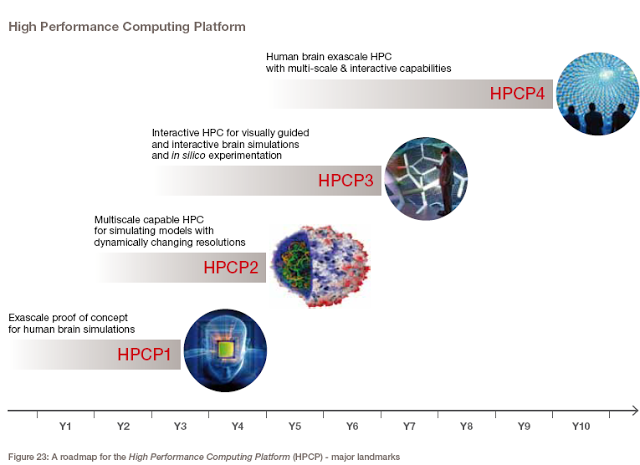6 Pilot Actions have been funded for a 12-month period starting in May 2011. In the second half of 2012 two of the Pilots will be selected and launched as full FET Flagship Initiatives in 2013.
The six FET Flagship Pilot Actions are:
* FuturICT – The FuturICT Knowledge Accelerator and Crisis-Relief System: Unleashing the Power of Information for a Sustainable Future
* Graphene – Graphene Science and technology for ICT and beyond
* Guardian Angels – Guardian Angels for a Smarter Planet
* HBP – The Human Brain Project
* ITFoM – IT Future of Medicine: a revolution in healthcare
* RoboCom – Robot Companions for Citizens
Report of the Human Brain Project (108 pages)
We propose that the HBP should be organised in three phases, lasting a total of ten years.
For the first two and a half years (the “ramp-up” phase), the project should focus on setting up the initial versions of the ICT platforms and on seeding them with strategically selected data. At the end of this phase, the platforms should be ready for use by researchers inside and outside the project.
For the following four and a half years (the “operational phase”), the project should intensify work to generate strategic data and to add new capabilities to the platforms, while simultaneously demonstrating the value of the platforms for basic neuroscience research and for applications in medicine and future computing technology.
In the last three years (the “sustainability phase”), the project should continue these activities while simultaneously moving towards financial self-sustainability – ensuring that the capabilities and knowledge it has created become a permanent asset for European science and industry.
The Human Brain Project would enormously accelerate progress towards a multi-level understanding of brain structure and function, towards better diagnosis, better understanding, and better treatment of brain diseases and towards new brain-inspired Information and Communications Technologies. The impact on European science, European industry, the European economy and European society is potentially very large.
By integrating brain research with ICT, the HBP would help to determine the future direction of computing technology. In supercomputing, new techniques of interaction and visualisation, multi-scale simulation and cloud computing developed by the project, would stimulate the development of new services for industry and consumers, initiating a virtuous circle in which increased demand leads to economies of scale and falling costs, and falling costs further boost demand, making supercomputers available to far wider sectors of academia and industry than at present. Many of these capabilities would depend on advanced software – an area in which Europe has a strong competitive advantage.
HBP work in neuromorphic computing and neurorobotics would open the road for the development of compact, low-power systems with the long-term potential to achieve brain-like intelligence. Although these technologies will not replace the “conventional” computing technologies that have driven the last fifty years of European growth, the range of their potential applications and their strategic importance are on the same scale. By taking the lead in their development, the HBP would play a vital role in securing Europe’s competitive position in the world economy.
Guardian Angels for a Smarter Planet
Providing Information and Communication Technologies to assist people in all sorts of complex situations is the long term goal of the Flagship Initiative, Guardian Angels. These Guardian Angels will be like personal assistants and are envisioned as intelligent (thinking), autonomous systems (or even systems-of-systems) featuring sensing, computation, and communication, and delivering features and characteristics that go well beyond human capabilities. It is intended that these will provide assistance from infancy right through to old age.
A key feature of these Guardian Angels will be their zero power requirements as they will scavenge for energy. Foreseen are individual health support tools, local monitoring of ambient conditions for dangers, and emotional applications. Research will address scientific challenges such as energy-efficient computing and communication; low-power sensing, bio-inspired energy scavenging, and zero-power human-machine interfaces.
Robot Companions for Citizens
Robot Companions for Citizens are soft skinned and sentient machines designed to deliver assistance to people. This assistance is defined in the broadest possible sense and covers all sorts of different settings. Based on multidisciplinary science and engineering, CA-RoboCom aims to develop a radically new approach towards machines and how these are deployed in society.
Robot Companions for Citizens will be based on the novel solid articulated structures with flexible properties displaying soft behaviour. These companions will also have new levels of perceptual, cognitive and emotive capabilities.
They will also be aware of their physical and social surroundings and respond accordingly. Such sentient characteristics will be achieved through understandings of the behaviour of sentient living creatures. In undertaking the research into the Information and Communication technologies that will need to be developed, the research will also validate understandings of the general design principles underlying biological bodies and brains, thus supporting a symbiotic relationship between science and engineering.
If you liked this article, please give it a quick review on ycombinator or StumbleUpon. Thanks

Brian Wang is a Futurist Thought Leader and a popular Science blogger with 1 million readers per month. His blog Nextbigfuture.com is ranked #1 Science News Blog. It covers many disruptive technology and trends including Space, Robotics, Artificial Intelligence, Medicine, Anti-aging Biotechnology, and Nanotechnology.
Known for identifying cutting edge technologies, he is currently a Co-Founder of a startup and fundraiser for high potential early-stage companies. He is the Head of Research for Allocations for deep technology investments and an Angel Investor at Space Angels.
A frequent speaker at corporations, he has been a TEDx speaker, a Singularity University speaker and guest at numerous interviews for radio and podcasts. He is open to public speaking and advising engagements.



